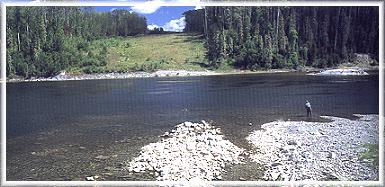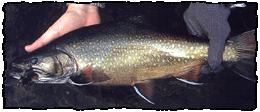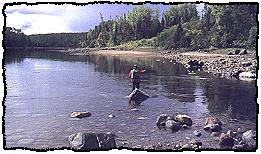Fishing Lake Superior Streams
The Lower Nipigon River
By Scott E. Smith
Lower Nipigon River
From Alexander's Dam to Nipigon Bay on Lake Superior is a
25-kilometer stretch of the famous Nipigon River, home of the
world-record brook trout. The river's clear, wide, powerful waters
appear at first to be gentle and forgiving, but once you wade into this
magnificent and sometimes formidable river you will soon learn to
respect her omnipotence. The average flow at Alexander's is 12000
cfs (cubic feet per second). In years of low flow, the Nipigon fishes
like a world-class blue-ribbon river, with gorgeous runs, gravel bars
and prolific hatches. Unfortunately the demands for hydroelectric
power dictate high water levels that tend to emcumber the best hatches.
Nevertheless the fish are always present and can be hooked with regularity
if you adapt your techniques properly.

During non-hatch periods the best approach is to swing large rabbit-strip
patterns through deep current seams and beside structure. The fish in the
Nipigon, to a great extent, are bank oriented. Deep holding lies a few feet
from the bank provide ideal feeding stations with protection from predation
and relentless current: providing nicely all the needs of a trout. Whether you
are fishing from the bank or working the shoreline from a boat, cautiously
cast quartering downstream and place your fly right beside the shore.
Often a trophy-sized rainbow or brook trout will be stationed there.

. . . In the lower stretch of the river, the giant brook trout the river
has been made famous for, have been replaced to some extent with
large resident rainbow and summer steelhead. There is some debate as
to whether the rainbows are resident or transient Superior fish, but
regardless of their citizenship they are ass-kickers on a fly rod. I have
taken rainbows in mid-summer on dries and streamers anywhere from five
to eight pounds. They immediately go airborne when they feel the hook
and rip off backing in seemingly endless runs. These are chunky and
well-fed fish, a testament to the prolific tailwater conditions providing
by damming of the river. (Not all progress is negative.)
The evening hatch on the lower Nipigon in June and July can be incredible.
Clouds of caddis come off the river starting about two hours before dark,
which can be as late as 11:00 p.m. in this latitude. Giant Salmon flies
are encountered on the water during this same time period, primarily in
the evening, but also to a lesser extent during mid-afternoon on cloudy
days. These Giant salmonflies Pteronarcys dorsata are
some of the biggest of the species you will encounter anywhere; the adult
insect often being a full three inches in length. In fact, a good friend of
mine, Mike Sewards, momentarily mistook these insects for some type of
"water-bat" the first time he fished the river during this hatch. When the
Pteronarcys are coming off the water in good numbers you can rest assured
all the biggest trout in the river will be keyed in on them. they provide a very
worthwhile meal for trophy trout, which often will not move to the surface
for lesser offerings.
 Considering the lack of fly-fishing pressure, suprisingly enough the trout
in the lower Nipigon can be very selective. I have spent countless evenings
trying to figure out what exactly the fish were rising for. As most ardent
dry-fly anglers can attest, watching chunky trout boil around your fly time
after time can be very frustrating until you find just the right presentation or
pattern. I like to fish dries on the Nipigon's clear, flat surface on a downstream
presentation with a long leader (up to sixteen feet). Early in the evening
you should run a fairly light tippet - say 5X - and your leader should be
treated with floatant right up to within two feet of the fly. I leave
this portion of tippet without floatant so that it sinks slightly in the surface
film and is not so evident to the fish. Quite often I have found that fussy fish
are not taking off the surface at all, but are actually taking subsurface emergers;
switching to a Floating Mayfly Nymph or a Timberline Emerger under these
conditions will often result in hookups. During a good evening or morning
hatch on the lower river you will encounter rainbows, brook trout and whitefish.
The latter sometimes exceeding five pounds. This interesting combination of
species adds to the mystique of the Nipigon.
Considering the lack of fly-fishing pressure, suprisingly enough the trout
in the lower Nipigon can be very selective. I have spent countless evenings
trying to figure out what exactly the fish were rising for. As most ardent
dry-fly anglers can attest, watching chunky trout boil around your fly time
after time can be very frustrating until you find just the right presentation or
pattern. I like to fish dries on the Nipigon's clear, flat surface on a downstream
presentation with a long leader (up to sixteen feet). Early in the evening
you should run a fairly light tippet - say 5X - and your leader should be
treated with floatant right up to within two feet of the fly. I leave
this portion of tippet without floatant so that it sinks slightly in the surface
film and is not so evident to the fish. Quite often I have found that fussy fish
are not taking off the surface at all, but are actually taking subsurface emergers;
switching to a Floating Mayfly Nymph or a Timberline Emerger under these
conditions will often result in hookups. During a good evening or morning
hatch on the lower river you will encounter rainbows, brook trout and whitefish.
The latter sometimes exceeding five pounds. This interesting combination of
species adds to the mystique of the Nipigon.
Steelhead also spawn in the Nipigon and can be encountered year-round
in the lower river. Steelhead are taken near spawning lies in April, May
and June on egg and nymph patterns, but a more productive time for
steelhead on the Nipigon is post-spawn. In early to late June (depending
on the year), post-spawn steelhead will smash a black Woolly Bugger
swung deep on a sink-tip line with reckless abandon. Because of the
size of the river and the amount of feed in this tailwater section, the
steelhead recover quickly from the rigors of spawning and fight exceptionally
well. A ten-pound steelhead in the Nipigon will leave you trembling at the
knee, and well into your backing. Biologists feel that the river gets a run
of summer steelhead and it definitely get a run of large agressive steelhead
in the fall. During summer I have encountered bright chrome fish as well
as deep-bodied, colourfully detailed rainbows. I can only assume the
latter are resident fish and the sleeker, brighter fish are summer steelhead.
More on the Nipigon and other recommended rivers next time! ~ Scott E. Smith
Excerpt from: Ontario
Blue-Ribbon Fly Fishing Guide
Published by: Frank Amato Publications, Inc.
P.O. Box 82112, Portland Oregon 97282 Phone: 503-653-8108,
email Frank Amato Publications
Our Man In Canada Archives
|



